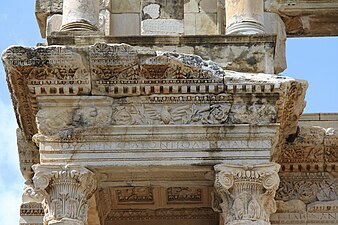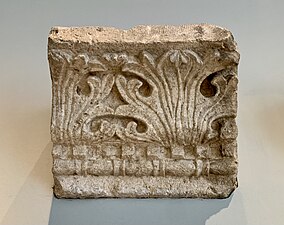Bead and reel

Bead and reelis an architectural motif, usually found in sculptures, moldings and numismatics. It consists in a thin line where beadlike elements alternate with cylindrical ones.[1][2]It is found throughout the modern Western world in architectural detail, particularly on Greek/Roman style buildings, wallpaper borders, and interior moulding design. It is often used in combination with theegg-and-dartmotif.[3]
According to art historianJohn Boardman,the bead and reels motif was entirely developed in Greece from motifs derived from the turning techniques used for wood and metal, and was first employed in stone sculpture in Greece during the 6th century BC. The motif then spread toPersia,Egyptand the Hellenistic world, and as far asIndia,where it can be found on theabacuspart of some of thePillars of Ashokaor thePataliputra capital.[4]Bead and reel motifs can be found abundantly in Greek and Hellenistic sculpture and on the border of Hellenistic coins.
Gallery[edit]
-
Ancient Greekbead and reel on the base of acapitalfrom the ruins of the Temple of Apollo atDidyma,Turkey,unknown architect or sculptor,c.300-150 BC[5]
-
Bead and reel at the base of the capital of aPillar of Ashoka,inVaishali,India, unknown architect or sculptor, 3rd century BC
-
Friezeof the lost capital of theAllahabad pillar,with twolotusesframing a"flame palmette"surrounded by smallrosetteflowers, over a band of bead and reel, 3rd century BC, unknown material,Allahabad Museum,Prayagraj,India
-
Gold 20-staterofEucratides Iwithin a bead and reel border, 2nd century BC,Cabinet des Médailles,Paris
-
Ancient GreekIoniccapital with bead and reel, from the Temple of Artemis Leukophryene at Magnesia on the Maeander, 2nd century BC, unknown type of stone,Pergamon Museum,Berlin
-
RomanCompositecapitals with bead and reel of theLibrary of Celsus,Ephesus,Turkey,unknown architect,c.110AD
-
Roman Composite capital with bead and reel of the Ancient Theatre ofOstia Antica,near modernOstia,southwest of Rome, unknown architect, late 2nd century
-
Byzantinebead-and-reel on a basket capital in theHagia Sophia,Istanbul,Turkey,byAnthemius of TrallesorIsidore of Miletus,6th century
-
Islamicbead and reel on a cornice,c.705-715, limestone, Pergamon Museum
-
RenaissanceComposite pilaster capital with bead and reel and agorgonmascaron,by a Florentine pupil ofVerrocchioactive in Rome, perhapsMichele Marini da Fiesole,c.1485-1495, terracotta,Museo di Roma,Rome
-
Renaissance entablature with bead and reel of theLescot Wingof theLouvre Palace,Paris, byPierre Lescot,1546-1551[6]
-
Baroquebead and reel on a tapestry showing the Triumph ofConstantineoverMaxentiusat theBattle of the Milvian Bridge,designed byPeter Paul Rubensin 1622, produced from 1623 until 1625, wool and silk with gold and silver threads,Philadelphia Museum of Art,Philadelphia,US
-
Neoclassicalbead and reel on a piece of textile, by Séquin & Co. fro,Lyons,1811, silk plain weave with silk brocading wefts, Philadelphia Museum of Art
-
Art Nouveaufrieze withfestoons,bordered at the top by a bead and reel strip, inCalea Dorobanțilorno. 50A,Bucharest,Romania,unknown architect or sculptor,c.1900
-
Art Decobead and reel onPiața Mihail Kogălniceanuno. 1, Bucharest, unknown architect or sculptor,c.1930
See also[edit]
References[edit]
- ^"bead and reel".Glossary Medieval Art and Architecture.pitt.edu.Retrieved12 August2016.
- ^"Bead and Reel".artlandia.Retrieved12 August2016.
- ^Sturgis, Russell (1901).A Dictionary of Architecture and Building, Volume I.Macmillan. p. 256.
- ^John Boardman, "The Origins of Indian Stone Architecture", p.16 and others[1]
- ^"Temple of Apollo at Didyma".brown.edu.Retrieved6 March2024.
- ^John Summerson (1963).The Classical Language of Architecture.London and New York City: Thames & Hudson. p. 76.

![Ancient Greek bead and reel on the base of a capital from the ruins of the Temple of Apollo at Didyma, Turkey, unknown architect or sculptor, c.300-150 BC[5]](https://upload.wikimedia.org/wikipedia/commons/thumb/d/d8/Didyma_2013-03-25zb.jpg/383px-Didyma_2013-03-25zb.jpg)









![Renaissance entablature with bead and reel of the Lescot Wing of the Louvre Palace, Paris, by Pierre Lescot, 1546-1551[6]](https://upload.wikimedia.org/wikipedia/commons/thumb/c/c3/Paris_-_Palais_du_Louvre_-_PA00085992_-_219.jpg/338px-Paris_-_Palais_du_Louvre_-_PA00085992_-_219.jpg)




